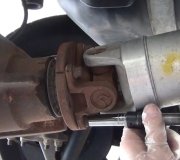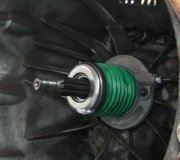NOTE: The curb and fast idle speeds are controlled by the EEC-IV processor and the Air Bypass Valve Assembly. The Air Bypass Valve Assembly is not adjustable. A large increase or decrease in closed plate airflow from the calibrated level will not allow this device to control the speed.
The idle speed setting procedure has been revised considerably to reflect the expanded application of the Self-Test idle speed options and because the throttle body incorporates an orifice in the throttle plate to control idle airflow as part of the sludge tolerant design.
Throttle bodies with sludge tolerant design are clearly identified with a Yellow/Black decal. This decal warns that the throttle plate stop screw must not be adjusted counter-clockwise (backed off), as this will not reduce the engine speed but may cause the throttle plate to stick in the bore. Backing out the screw may be required if the throttle body has been previously serviced (a plug in the throttle plate orifice may be present) or the plate stop screw tampered with (TPS Self-Test output out of range). The decal also warns that the throttle body must NOT be cleaned inside the bore, as this cleaning will impair the sensitive coating. The sludge accumulation will not affect the idle air flow. The cleaning procedure for the Idle Air Bypass Valve (IABP) still applies.
REMEMBER
A change in idle airflow can occur not only at the throttle body but other areas as well. You should enter the idle speed procedure only after other possible causes in the following areas are eliminated.
Contamination within the idle speed control device
Lack of fuel system control (excessively rich or lean)
Throttle sticking or binding
Engine not reaching operating temperature
Incorrect ignition timing
Incorrect or clogged PCV system
Vacuum leaks (intake manifold, vacuum hoses, vacuum reservoirs, power brake booster etc.
VERIFY
Transmission is in PARK or NEUTRAL
Parking brake is applied (automatic brake released where applicable)
Wheels blocked
Engine at operating temperature
Proper fuel pressure and no exhaust smoke
Correct and clean PCV system
Heater, A/C, and other accessories OFF
Ignition timing is set to specification
EEC-IV diagnostics have been performed and vehicle malfunction indicated service output codes have been resolved
PROCEDURE - STAR TESTER OR EQUIVALENT SCANNER REQUIRED
STEP 1
Activate engine running Self-Test.
STEP 2
After service code 11 or 111 has been displayed, unlatch and within 4 seconds latch the STI button.
STEP 3
A single pulse code indicates the entry mode, then observe the Self-Test Output (STO) of the STAR tester in step 4. If adjustment is required in step 4, ensure all other causes have been addressed and corrected before continuing.
STEP 4
A constant tone, solid light or "STO LO" readout means base idle rpm is within range. To exit test, unlatch STI button, then wait 4 seconds for reinitialization (after 10 minutes it will exit by itself).
Beeping tone, flashing light, or "STO LO" readout at (8 Hz) indicates Throttle Position Sensor is out of range due to over adjustment; adjustment may be required.
Beeping tone, flashing light, or "STO LO" readout at (4Hz) indicates base idle rpm is too fast, adjustment is required, go to STEP 6.
Beeping tone, flashing light, or "STO LO" readout at (1Hz) indicates base idle is too low, adjustment is required, go to STEP 5.
STEP 5
DO NOT clean the throttle body. Check the plate orifice plug. If there is no plug, turn screw clockwise until conditions in STEP 4 are satisfied. If there is a plug from previous service remove plug and then adjust screw in either direction as required. Screw must be in contact with the lever pad after adjustment. Proceed with step 7.
STEP 6
Turn engine OFF
Block the orifice in the throttle plate temporarily with tape. If the orifice already has a plug from previous service, go to STEP d.
Typical Throttle Return Screw Location
c Restart the engine and check idle speed using Self-Test (Mass Airflow models require the air intake hose to be reattached first). If engine stalled, crack open the plate with the throttle plate stop screw
If rpm continues to be fast, perform Key On Engine Off (KOEO) self test. If the TPS output code is within range, remove tape and check for other causes.
If out of range adjust screw for proper TPS code (lever pad must be in contact with screw after adjustment). If rpm is still fast, terminate this procedure and check for other possible causes.
If rpm drops to or below the desired level, as indicated by Self-Test Output tone, turn the engine OFF, disconnect air cleaner hose and remove tape.
Install the plug with the proper color code depending on the throttle plate orifice size.
Reconnect the air cleaner hose, start the engine and turn the plate stop screw clockwise (DO NOT turn it counter-clockwise as this may cause the throttle to stick at idle) until the conditions in STEP 4A are satisfied.
STEP 7
Run the Key ON Engine OFF (KOEO) Self-Test for proper TPS output code.
STEP 8
Verify the throttle is not stuck in the bore and linkage is not preventing the throttle from closing.
STEP 9
On automatic overdrive transmission (AOD) applications check the Throttle Valve (TV) pressure adjustment.
Tuesday, January 17th, 2012 AT 11:07 AM


